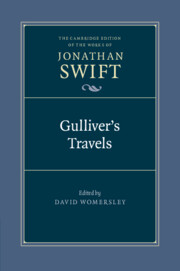Book contents
- Frontmatter
- Contents
- List of Illustrations
- General Editors’ Preface
- Acknowledgements
- Chronology of Swift’s Life
- Chronology of Gulliver’s Travels
- List of Abbreviations
- Introduction
- Gulliver’s Travels
- A Letter From Capt. Gulliver, to His Cousin Sympson
- The Publisher to the Reader
- The Contents
- Part I
- Part II
- Part III
- Part IV
- Long Notes
- Appendices
- Textual Introduction
- Select Bibliography
- Index
Chapter III
Published online by Cambridge University Press: 02 September 2021
- Frontmatter
- Contents
- List of Illustrations
- General Editors’ Preface
- Acknowledgements
- Chronology of Swift’s Life
- Chronology of Gulliver’s Travels
- List of Abbreviations
- Introduction
- Gulliver’s Travels
- A Letter From Capt. Gulliver, to His Cousin Sympson
- The Publisher to the Reader
- The Contents
- Part I
- Part II
- Part III
- Part IV
- Long Notes
- Appendices
- Textual Introduction
- Select Bibliography
- Index
Summary
A Phænomenon solved by modern Philosophy and Astronomy. The Laputians great Improvements in the latter. The King's Method of suppressing Insurrections.
I desired Leave of this Prince to see the Curiosities of the Island; which he was graciously pleased to grant, and ordered my Tutor to attend me. I chiefly wanted to know to what Cause in Art or in Nature, it owed its several Motions; whereof I will now give a philosophical Account to the Reader.
The flying or floating Island is exactly circular; its Diameter 7837 Yards, or about fourMiles and an Half, and consequently contains ten Thousand Acres. It is three Hundred Yards thick. The Bottom, or under Surface, which appears to those who view it from below, is one even regular Plate of Adamant, shooting up to the Height of about two Hundred Yards. Above it lye the severalMinerals in their usualOrder; and over all is a Coat of rich Mould ten or twelve Foot deep. The Declivity of the upper Surface, from theCircumference to the Center, is the naturalCause why all the Dews and Rains which fall upon the Island, are conveyed in small Rivulets towards the Middle, where they are emptyed into four large Basons, each of about Half a Mile in Circuit, and two Hundred Yards distant from the Center. From these Basons the Water is continually exhaled by the Sun in the Day-time, which effectually prevents their overflowing. Besides, as it is in the Power of the Monarch to raise the Island above the Region of Clouds and Vapours, he can prevent the falling of Dews and Rains whenever he pleases. For the highestClouds cannot rise above twoMiles, as Naturalists agree, at least they were never known to do so in that Country.
At the Center of the Island there is a Chasm about fifty Yards in Diameter, from whence the Astronomers descend into a large Dome, which is therefore called Flandona Gagnole, or the Astronomers Cave; situated at theDepth of an HundredYards beneath the upper Surface of the Adamant. In this Cave areTwenty Lamps continually burning, which from the Reflection of theAdamant cast a strong Light into every Part.
- Type
- Chapter
- Information
- Gulliver's Travels , pp. 240 - 248Publisher: Cambridge University PressPrint publication year: 2012

